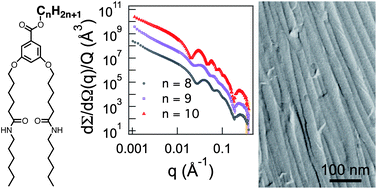Self-assembling properties of a series of homologous ester-diamides – from ribbons to nanotubes†
Abstract
We have studied the aggregation properties of a series of compounds BHPB-n bearing two amide groups and an

* Corresponding authors
a
Centre National de la Recherche Scientifique, Institut Charles Sadron, 23 rue du Loess, BP 84047, Strasbourg, France
E-mail:
mesini@ics-cnrs.unistra.fr, combet@ics-cnrs.unistra.fr
Fax: +33 3 88 41 40 99
Tel: +33 3 88 41 40 70
b Institut laue Langevin, 6 rue Horowitz, BP 156, Grenoble, France
c Laboratoire Léon Brillouin, Bât. 563 CEA Saclay, 91191 Gif sur Yvette, France
d International Center for Frontier Research in Chemistry, 8 allée Gaspard Monge, Strasbourg, France
We have studied the aggregation properties of a series of compounds BHPB-n bearing two amide groups and an

 Please wait while we load your content...
Something went wrong. Try again?
Please wait while we load your content...
Something went wrong. Try again?
F. Simon, T. T. T. Nguyen, N. Díaz, M. Schmutz, B. Demé, J. Jestin, J. Combet and P. J. Mésini, Soft Matter, 2013, 9, 8483 DOI: 10.1039/C3SM51369F
To request permission to reproduce material from this article, please go to the Copyright Clearance Center request page.
If you are an author contributing to an RSC publication, you do not need to request permission provided correct acknowledgement is given.
If you are the author of this article, you do not need to request permission to reproduce figures and diagrams provided correct acknowledgement is given. If you want to reproduce the whole article in a third-party publication (excluding your thesis/dissertation for which permission is not required) please go to the Copyright Clearance Center request page.
Read more about how to correctly acknowledge RSC content.
 Fetching data from CrossRef.
Fetching data from CrossRef.
This may take some time to load.
Loading related content
